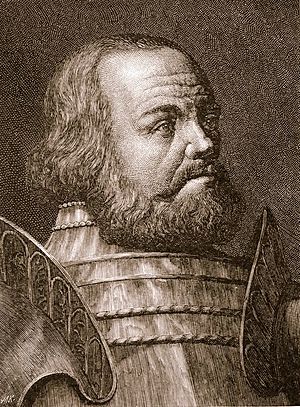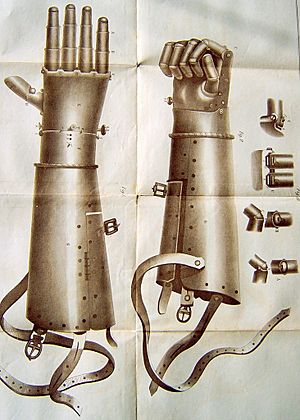Götz von Berlichingen facts for kids
Quick facts for kids
Reichsritter
Götz von Berlichingen
|
|
|---|---|

Götz von Berlichingen, 17th century engraving
|
|
| Born | 15 November 1480 Burg Jagsthausen, County of Württemberg, Holy Roman Empire
|
| Died | 23 July 1562 (aged 81) Hornberg Castle, Electoral Palatinate, Holy Roman Empire
|
| Resting place | Schöntal Abbey, Schöntal, Germany |
| Other names | Gottfried von Berlichingen |
| Occupation | Imperial Knight Mercenary |
| Years active | 1497-1544 |
| Known for | His iron prosthetic hand |
| Children | Hans Jakob von Berlichingen |
| Parents |
|
Gottfried "Götz" von Berlichingen (born November 15, 1480 – died July 23, 1562) was a famous German knight and soldier from the 1500s. He is best known as "Götz of the Iron Hand" because he wore a special metal hand after losing his own in battle.
Götz was an Imperial Knight, which meant he served the Holy Roman Emperor. He also worked as a mercenary, fighting for different leaders. He was born into a noble family in what is now Germany. Götz bought Hornberg Castle in 1517. He lived there until he died in 1562. Götz fought in many wars and battles for over 40 years. He even wrote about his life and adventures.
Contents
Götz's Life and Adventures
In 1497, Götz started working for Frederick I. The next year, he joined the armies of Emperor Maximilian I. He fought in different parts of Europe, including Burgundy and Brabant. He also fought in the Swabian War.
By 1500, Götz decided to form his own group of soldiers. These soldiers were called mercenaries. They would fight for anyone who paid them. Götz and his group fought for various dukes and barons.
Losing His Arm and Getting an Iron Hand
In 1504, Götz was fighting in a war called the War of the Succession of Landshut. He was helping the Duke of Bavaria. During a battle, a cannon shot hit his sword. This pushed his sword against his right arm. He lost his arm at the wrist.
Even after this serious injury, Götz kept fighting. He had two special metal hands made. The first one was simple. It was made by a local blacksmith and a saddle maker. The second iron hand was much better. It could hold things like a shield, horse reins, or even a pen. Both of these amazing iron hands are on display today at Burg Jagsthausen.
Conflicts and Imperial Ban
After losing his arm, Götz continued his military life. He was involved in many "feuds." A feud was like a private war between noble families or cities. He fought for himself and helped his friends.
In 1512, Götz had a long-standing feud with the city of Nuremberg. He attacked a group of Nuremberg merchants. Because of this, Emperor Maximilian placed Götz under an "Imperial ban." This meant he was an outlaw and could be attacked by anyone. He had to pay a very large sum of money, 14,000 gulden, to be free again in 1514.
In 1516, Götz had another feud. This time it was with the Archbishop of Mainz. Götz and his soldiers raided an area called Hesse. They captured a count named Philip IV. The count's family had to pay 8,400 gulden for his safe return. For this action, Götz was again placed under an Imperial ban in 1518.
Imprisonment and Release
In 1519, Götz joined the Duke of Württemberg, who was at war. Götz defended a town called Möckmühl. But his soldiers ran out of supplies. He had to surrender the town. He was then taken prisoner. This was against the rules of surrender. He was handed over to the people of Heilbronn, a town he had raided many times.
Two of his knight friends helped him. They argued for his release in 1522. Götz was set free, but he had to pay 2,000 gulden. He also promised not to seek revenge on the people who held him.
The German Peasants' War
In 1525, a big rebellion started called the German Peasants' War. Götz led the rebel army in one area. He said he did not fully support their cause. He agreed to lead them partly because he had no other choice. He also hoped to stop the rebels from being too violent.
Götz found he could not control the rebels. After about a month, he left his command. He went back to his castle to stay safe.
After the war ended, Götz had to explain his actions. He was found innocent in 1526. However, in 1528, he was tricked into going to Augsburg. He was promised safe passage. But he was captured and held prisoner until 1530. He was only freed after promising again to stay at his Hornberg Castle.
Later Years and Death
Götz stayed near Hornberg Castle until 1540. Then, Emperor Charles V allowed him to leave. Götz served the Emperor in a war against the Ottoman Empire in Hungary in 1542. He also fought in France in 1544.
After these campaigns, Götz returned to Hornberg Castle. He lived the rest of his life peacefully. He died on July 23, 1562, at the age of 81 or 82. Götz was married twice. He had three daughters and seven sons.
Götz's Legacy
Götz wrote a book about his own life. It was called Mein Fehd und Handlungen, which means "My Feuds and Actions." This book was published in 1731.
A famous German writer named Goethe wrote a play about Götz in 1773. The play was called Götz von Berlichingen.
During World War II, a German military unit was named after him. It was called the 17th SS Panzergrenadier Division Götz von Berlichingen. Also, the German Navy used a symbol of Götz's "Iron Fist" on their squadron crest for many years.
Some people thought that a character named Guts from a Japanese comic book series, Berserk, was inspired by Götz. Both were mercenaries with iron hands. However, the creator of Berserk said it was just a strange coincidence.
See also
 In Spanish: Götz von Berlichingen para niños
In Spanish: Götz von Berlichingen para niños



